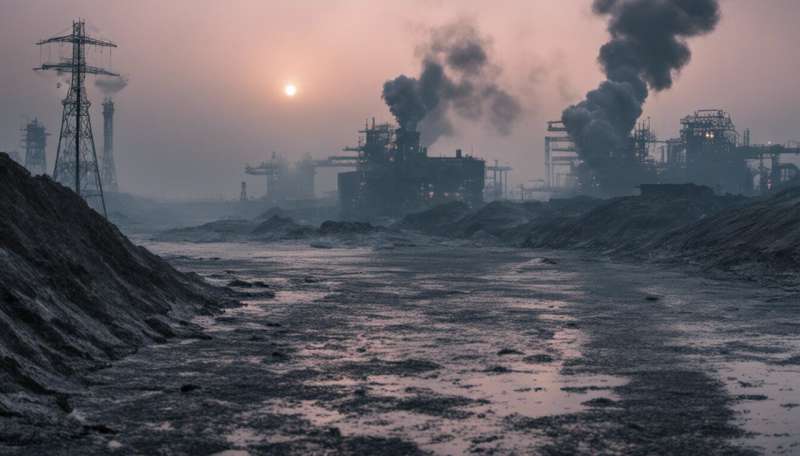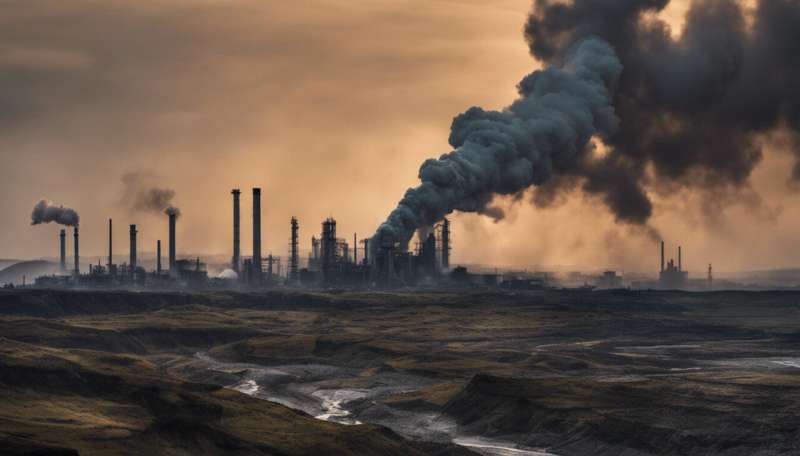Sulfur pollution from coal and gas is extreme, but new chemistry could clean it up

If humans created an emissions hall of shame, which pollutants would you nominate?
Carbon dioxide and methane would probably be fan favorites. But take a moment and consider my dark horse candidate: sulfur dioxide. Unlike its carbon-based counterparts, sulfur dioxide is not considered a and doesn't get as much attention in the media. Instead, it does its dirty work in other ways.
Sulfur dioxide is emitted primarily through the burning of fossil fuels from power plants, industry, automobiles, planes and ships. The sulfur dioxide then finds other atmospheric molecules in the air, combines with them, and forms .
These inhalable particles can be very small—some less than one-tenth the width of a human hair—and they contribute to acid rain, haze and smog. All of these and exacerbate existing conditions such as asthma. In fact, these particulates are considered the air .
developing technologies to solve challenging, large-scale problems like sulfur pollution on a molecular level.
A global problem
Living in Los Angeles, it's impossible to avoid sulfur-containing and it's a significant public health issue in as well. , including many cities India and China, have it even worse.
But there's a silver lining to our smog cloud. Whereas carbon dioxide is a necessary byproduct of fossil fuel combustion, sulfur dioxide is not. Unlike carbon, sulfur is actually an undesired contaminant in fuels. This means that if all of the sulfur could be removed from fossil fuels before they are burned, sulfur emissions would be slashed and pollution curbed.
Fortunately, most of the sulfur is already removed from fuels during refining through a remarkable chemical process called . The sulfur gets stripped from the fuel in the form of hydrogen sulfide, . But certain stubborn and these contaminants find their way into our gas tanks. For example, even ultra-low sulfur diesel (ULSD) contains about 10 to 15 parts-per-million of sulfur.
The hydrodesulfurization process relies on - it's very complex science and engineering. Catalyst and refining expert reflected on how sophisticated this process really is in In it, he noted that there are more countries with the technical capabilities to produce nuclear weapons than countries that can substantially refine fuels.
With the global demand for oil , scientists and engineers must quickly find a way to further reduce the quantity of sulfur in fuels, ideally to negligible levels. Such a breakthrough would allow a chance to breathe easier.

Accelerating chemistry
In 2016, I defended my Ph.D. in organic chemistry from the at . During my studies, my team and I discovered that a class of molecules containing the element and improve . This sort of behavior was very surprising because industrial catalysts often use expensive , like palladium, or other metals that require high temperatures to be active. In contrast, potassium is a component of common minerals. It is the - 20 million times more abundant than palladium and orders of magnitude less expensive.
So far, we have found uses for our potassium technology in a . By the time I left Caltech in 2016, we had a large number of granted and pending for this chemistry and we're working on many more now.
I was eager to begin applying these discoveries to address global problems, so that same year I teamed up with entrepreneurs Nick Slavin and Nova Spivack and founded to commercialize this technology.
Removing sulfur with potassium
In 2013, initiated by my friend and colleague at Caltech, , inspired us to consider using the potassium technology to remove sulfur from fuel. Four years later, Alexey and I, together with an international team of academic and industrial collaborators, published describing our findings.
The method proved very effective. In the laboratory, we could reduce the sulfur concentration in a sulfur-rich diesel fuel sample from 10,000 parts-per-million to two, exceeding the ambitious , and doing so .
Last year, two articles by Chinese scientists from multiple institutions in , and applied our potassium-based method to remove the sulfur from raw coal mined in the Xinyu and Guxian regions. Their experiments using test tube-sized quantities of coal were successful and in 80 minutes they removed more than 60% of the sulfur.
At this stage, our desulfurization method has not yet been used , so next steps involve implementing engineering solutions and tweaking the chemistry for scale-up.
Looking ahead
Although work needs to be done to improve the desulfurization technique to make it suitable for large-scale refining, these early results are encouraging. Nearly all , causing approximately 33 million people to live in areas with substantial sulfur dioxide pollution. In China, sulfur dioxide emissions primarily from coal burning are thought to contribute to more than .
In the next 20 years, the world's population will increase by about . This is expected to increase energy demand by 25% through 2040. And despite the push toward electrification and renewables, fossil fuels are expected to for decades, and it's crucial that they burn as cleanly as possible.
Provided by The Conversation
This article is republished from under a Creative Commons license. Read the .![]()














